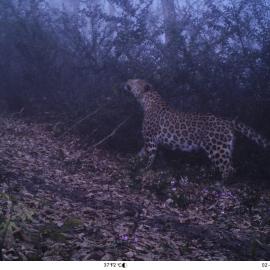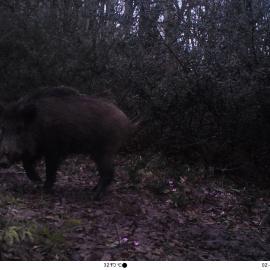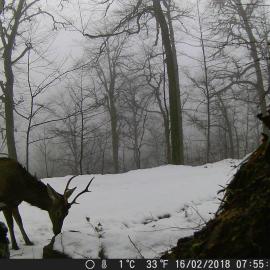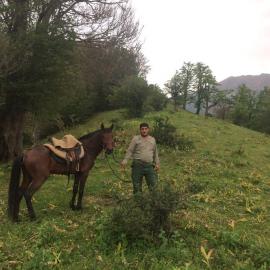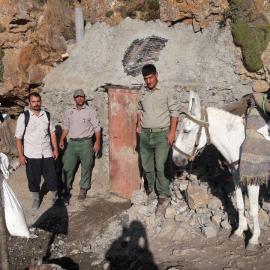Leopard Shield
Current initiative
Published
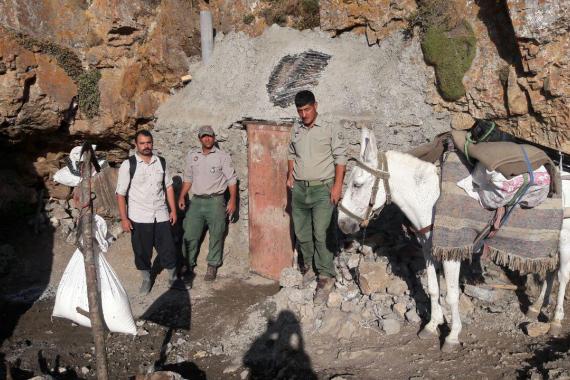
The anti-poaching team in front of a mountain ranger post. Credit: Future4Leopard Foundation
The Future4Leopards Foundation is providing incentives and mechanisms to local rangers and local people to protect the Persian Leopard in Iran. This includes capacity building, establishing a network of informants, funding two ex-hunters to serve as Leopard Guardians, and an education program for local children.
Location
In an area with a high density of rivers and other water resources, the Dohezar–Sehezar No Hunting Area is located in northern Iran’s Mazandaran province within the Caspian, or Hyrcanian, forest on the northern slopes of the Alborz mountains. With an area of at least 760 km2, it consists of a mix of rocky montane and forest lowlands, with altitudes ranging from 380 to 4,850 m and annual precipitation of 1,200 mm. The mean temperature ranges from 8 to 26°C in the coldest and warmest months, respectively.
The area has recently received official protection as a designated No Hunting Area. Persian ibex, maral (or Caspian) red deer, roe deer and wild pig are the main ungulates present in the area. Persian leopard and brown bear are two large carnivores that range here, along with smaller Eurasian lynx, jungle cat, stone marten, pine marten, etc.
Together with its southern counterpart in the Alborz range, the Alamut mountains, the area forms one of the largest hotspots for many of the aforementioned species, particularly the Persian leopard.
Most of the area hosts herding communities who use different pastures on a seasonal basis, normally at higher elevations above 2,000 m during summertime, migrating to lower elevations with the first rains in late summer. Sheep and goat are dominant in the highlands, while cattle are kept around lowland villages, all subject to occasional conflict with carnivores.
The poaching and wildlife trade problem
Species affected Persian Leopard Panthera pardus tulliana
Overview of the problem
Poaching (mainly of deer and wild pigs) occurs mainly for meat or recreation. Poaching of Leopards is usually a consequence of human-wildlife conflict.
The anti-IWT initiative
The main aim of the initiative is to protect the Persian leopard and its prey species by building the capacity of local rangers and engaging local people to help the rangers to prevent poaching. In addition, the Foundation is providing educational activities targeted at local school children.
In Iran, there are too few rangers who are inadequately trained and ill-equipped to effectively do their job. As a consequence moral and motivation is low. Furthermore, although most villagers live in proximity to National Parks, almost none of them are allowed to visit these protected areas. What they know and how they feel about these protected areas is mostly based on what they see on TV. This causes a degree of resentment - they feel that their right to explore the countryside around them is not respected and conflict between local people and the authorities can occur.
Future4Leopards Foundation is trying to address this by:
1. Providing training for the rangers, which includes leopard survey techniques and conflict resolution, and incentivising rangers by holding a bi-annual event that applauds and rewards 'outstanding' rangers (i.e. those who sight the most leopards and/or arrest the most number of poachers) for their work.
2. Establishing and maintaining a network of local informants who report poachers (mostly local herders) to local rangers.
3. Hiring 2 local people - including a local cattle rancher - as Leopard Guardians. They are paid the minimum wage and are properly equipped - e.g. with clothes, binoculars, 4WD vehicle, motorbikes and horses) to undertake their duties as a Guardian. Leopard Guardians undertake patrols, deploy cameras, and investigate cases of human-wildlife conflict - whilst tending his herd in the forest. Leopard Guardians work closely with rangers and have been given preliminary training. They contact rangers when poachers are sighted. Leopard Guardians are fully funded by Future4Leopards Foundation.
4. The Foundation is educating school students about leopards in the hope that they will pass this knowledge on to their families, and produce a generation that can co-exist with the leopard. Excursions - 'eco-trips' - to the National Park are provided to the children to given them a unique experience of wildlife etc. Thus, local people who do not normally visit National Parks can learn more.
The strategy
Strengthening disincentives for illegal behaviour
Two Leopard Guardians are funded by the Foundation - they are paid the minimum wage and are adequately equipped. They monitor the area and inform rangers of poachers.
Rangers are given training to help them undertake their duties more effectively.
A network of informants from the local community has been established.
Improving education and awareness
Further detailSchool children are the target of an educational program focussed on the leopard. They are also taken on excursions to the National Park to give them a unique and memorable experience. (noting that local people are not normally allowed to visit the National Park)
- more than 180 school children have attended two series of educational classes, from 18 villages around the area (Tandoureh).
- more than 100 children have been on the Foundation's eco-trips (excursions to the National Park).
Has the initiative made a difference?
It is too soon to know if this initiative is making a positive difference to the leopard population by reducing poaching, or if the educational programs are making a difference to the attitudes of the local people.
In general, fewer hunters are coming into the forest to shoot animals and local people seem to be developing an appreciation of nature (which is perceived as helping to reduce the incidence of poaching).
There have been some notable achievements, including:
- The arrest of a notorious poacher responsible for killing at least 100 animals. This was facilitated by the establishment of new and better access roads.
- 2 gangs of poachers were detected by camera traps, and who subsequently went to court.
- More than 30 poaching attempts were thwarted by Leopard Guardians (in partnership with local rangers).
In addition, the Leopard Guardians have gained social status and recognition.
Organisers, donors and partners
For further information contact Mohammad Farhadinia (mohammad.farhadinia@zoo.ox.ac.uk).


